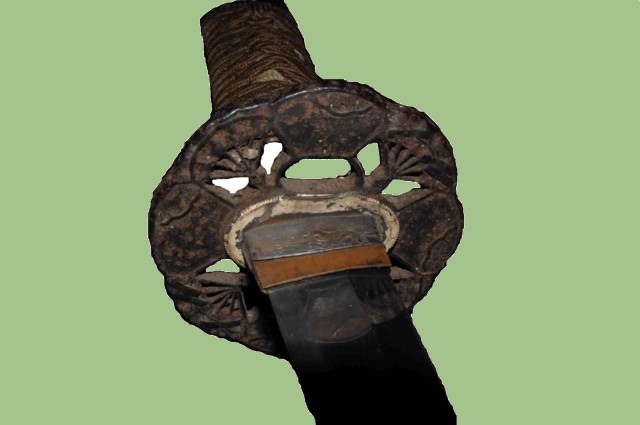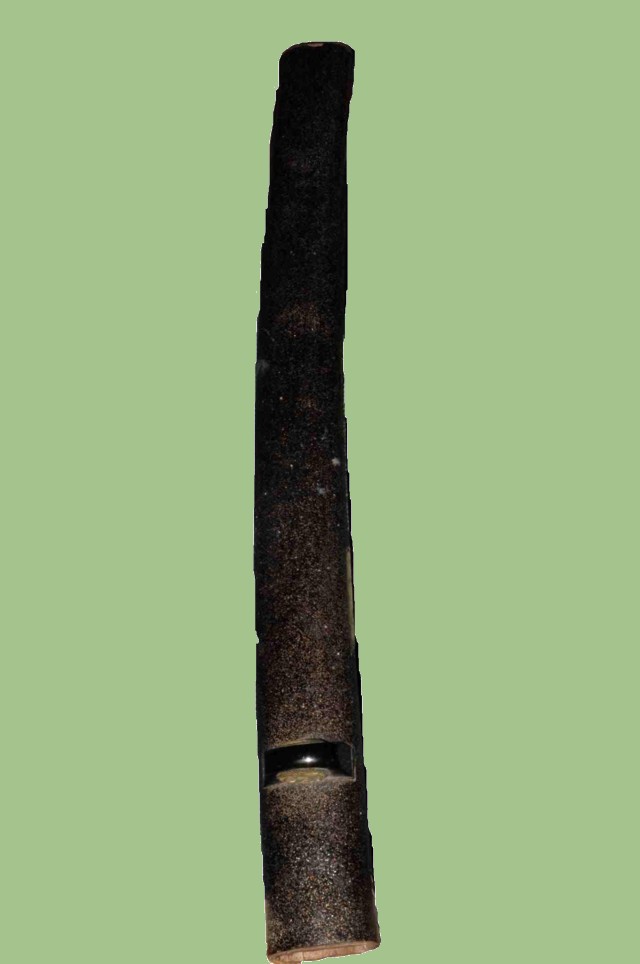SAMURAI SWORD 31 - 1800's TANTO
The tanto knife was used by the Samurai Warrior for close in fighting. This is also the knife that was
often employed when committing suicide. It was the smallest of the blades that was used by the Samurai
in combat. It was also carried to combat by Japanese soldiers during WWII. The small size ade it ideal
for use in aircrafts, tanks and other places with limited space.
The item featured on this page is a Japanese Tanto knife. It is outfitted in traditional dressings.


The Habaki is constructed of two separate pieces. The top part has a curved design and is of different color. The
bottom section is closer to the standard Habaki.
The blade seems to retain the original polish. It shows little wear to the edge. No major dings or damage is present.
A straight Hammon line is visible.

The Tsuba is of earlier manufacturing. Multiple sections are hollowed out and simulate trees from a branch. At least
one spacer is present.


The following pictures shows a side view of the handle. The brass metal ring is placed at the base of the handle.
It is of very simple design. The handle is wrapped with brown cloth. The inside is lined with ray skin that has a
bumpy texture. The Menuki is clearly visible and has a matching set on the other side. The handle is held in place
by a single pin.

|
This page is a recognition and identification guide for Samurai swords.
Multiple detailed photos of a specific sample are provided. Descriptions point
out clearly defined points that should be noted.
One of the most commonly asked questions is "How much is my Samurai Sword worth?".
A price guide is included here to address this question. The value of the swords is
reviewed over a period of several years. A trend can be observed. The present worth
of the edge weapons in the collector's market is illustrated.
This service is provided free of charge to the visitor/enthusiast courtesy of
MilitaryItems.com,
a company dedicated to the preservation of military history and to providing quality
military antiques and collectibles to museums, institutions and the general public.
|
|

The scabbard is lacquered with a dotten pattern. very beautifully executed. A suspension ring is built right into
the side of the body. The opposite side has a rectangular opening. This is where a smaller utility knife would be
carried. The inside of the scabbard shows the raw wood. There is no locking mechanism for this sword.

The following photos provide a view of the Tsuba from the top. The same branch pattern as the other side is found.
Also visible here is the pommel cap which has the image of a dragon executed in guild. very fine workmanship as the
dragon figure was created as a separate piece that was then soldered to the cap.

Ususally the motiff of the pommel cap was reverbarated in the base ring and the Tsuba. In this case the design is not
the same. This could indicate that parts have been changed since the sword was initially created.

This Samurai Sword may be currently reproduced.
It is becoming more difficult to be able to tell the fake ones from the real ones because
the quality of the reproductions is improving. The collector must become familiarized with
the construction style and materials employed in the manufacturing of this item.
Attention to the details is critical in order to be able to determine the authenticity of
the collectible.
If you have an interest is seeing other Japanese Samurai swords, you can do so by going to our
Japanese Samurai Swords Price Guide
identification guide. Where we cover Samurai swords from all periods.
| 




